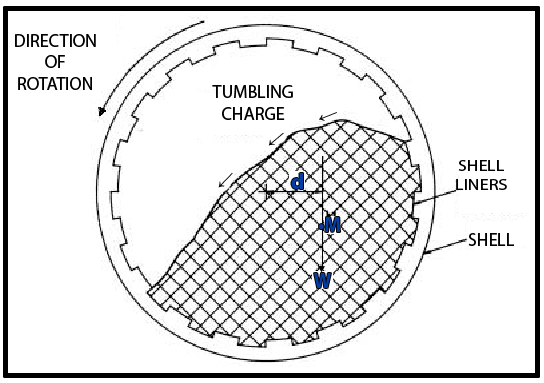Why Do We See an Increase in the Power of Our Ball Mill When We Turn Off the Feed
We are often asked this question by Mill Operators. During a grinding circuit shut-down, when the feed is shut off and the mill is grinding itself out, a small (sometimes 2 to 3%) increase in the motor power draw is often observed. Similarly, on start-up, the power drops measurably when the feed is first turned on. This is counter-intuitive, so sometimes creates concern over the reliability of the power instruments.
There is nothing wrong with the power instruments. To understand this common occurrence, consider that the power drawn by the ball mill can be thought of in terms of the total weight of the charge (W, of balls plus rock and water) being held in suspension by the rotating shell with the center of the entire mass inside the mill at location (M). See the figure below. Power equals speed times torque, so with fixed mill speed, power is related directly to torque. Torque equals force times distance; in this case, the weight of the charge is the force (acting vertically downward); and the distance through which this force is acting is the horizontal distance (d) from the center of rotation of the mill to the center of mass located at point M.

Now, given this picture, suppose the mill is running with no ore feed. The power is directly related to W x d. When the feed is turned on, W increases, now equal to the weight of the balls plus ore (and water) in the mill. But the rock also swells the charge, moving the center of the entire mass closer to the center of the mill, and thus decreasing the horizontal distance (d). The product of the new (larger) W times the new (smaller) d with the feed on is normally lower for mills operating with typical ball load levels. So the power falls when the feed comes on.
The reason this does not occur with semi-autogenous grinding (‘SAG’) mills is that the change in the weight of the charge dominates over the (horizontal) distance from the mill center line as the mill loads up with ore. However, the same principles of physics apply in determining the power draw of all rotary grinding mills.
